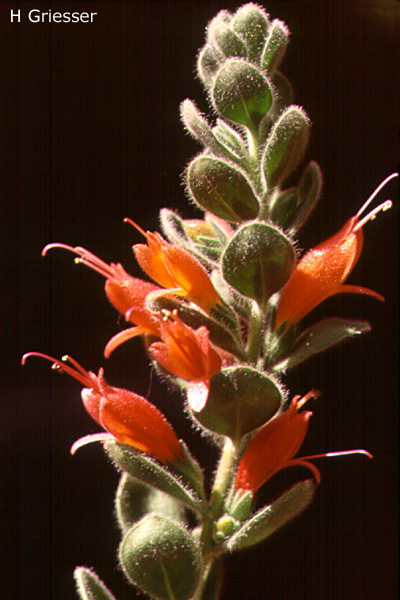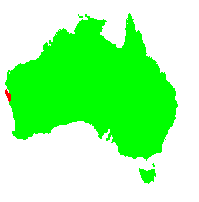General Description:
Eremophila is a large genus of 214 species, all endemic to Australia. They are generally plants of inland and arid areas and are popular with Australian plant enthusiasts.
Eremophila splendens was formerly regarded as an unnamed subspecies of Eremophila glabra (E.glabra subsp. Shark Bay). It is a small shrub up to 1 – 1.5 metres high. The leaves are greyish green in colour, about 40 mm long and quite hairy. The flowers are usually deep red in colour, up to 30 mm long and tubular in shape. They mainly occur in spring.
E.splendens has undoubtedly been cultivated as a form of E.glabra. However, due to the somewhat confusing situation with that species, there is little available data of the performance of E.splendens in cultivation. Based on its habit and natural distribution, it would be expected to prefer dry climates in a well drained, sunny position. It is likely to be unreliable in humid, temperate areas.
Propagation from seed of Eremophila species is unreliable. A number of treatment methods have been tried including sowing the ripe fruits, sowing of aged and washed fruits and splitting the fruits to extract the seeds prior to sowing. The latter involves splitting the fruits in halves and quarters but some seeds are inevitably damaged during the process.
E.splendens is likely to strike from cuttings of hardened, current season’s growth. However, the hairy foliage may rot under misting conditions.
* EPBC Act = Environment Protection and Biodiversity Conservation Act 1999;
ROTAP = Rare or Threatened Australian Plants (Briggs and Leigh, 1988)
For further information refer the Australian Plants at Risk page

Eremophila splendens
Photo: Hans Griesser
Images of all Eremophila species, hybrids and cultivars can be seen in the Eremophila Study Group’s Eremophila Image Database
 Australian Native Plants Society (Australia)
Australian Native Plants Society (Australia)













